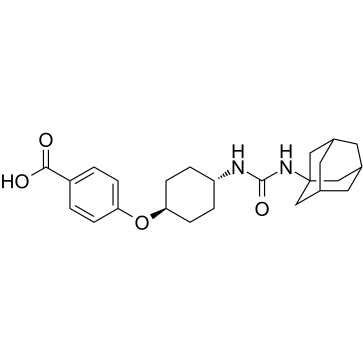885012-33-9
| Name | trans-ACUB |
|---|---|
| Synonyms |
4-({trans-4-[(tricyclo[3.3.1.13,7]dec-1-ylcarbamoyl)amino]cyclohexyl}oxy)benzoic acid
4-({trans-4-[(Adamantan-1-ylcarbamoyl)amino]cyclohexyl}oxy)benzoic acid Benzoic acid, 4-[[trans-4-[[(tricyclo[3.3.1.13,7]dec-1-ylamino)carbonyl]amino]cyclohexyl]oxy]- |
| Description | trans-AUCB (t-AUCB) is a potent, orally active and selective soluble epoxide hydrolase (sEH) inhibitor with IC50s of 1.3 nM, 8 nM, 8 nM for hsEH, mouse sEH and rat sEH, respectively. trans-AUCB has anti-glioma activity[1][2]. |
|---|---|
| Related Catalog | |
| Target |
IC50: 1.3 nM (hsEH), 8 nM (mouse sEH) and 8 nM (rat sEH)[2] |
| In Vitro | trans-AUCB (t-AUCB; 25-300 μM; 48 hours) suppresses U251 and U87 cell growth in a dose-dependent manner[1]. trans-AUCB (200 μM; 48 or 96 hours) induces cell-cycle G0/G1 phase arrest in U251 and U87 cells[1]. trans-AUCB (200 μM; 10 min-4 hours) can increase the phosphorylation levels of p65 after 10 min, reaching to peak after 30 min and lasting for at least 2 hours[1]. trans-AUCB (200 μM; 48 hours) suppresses U251 and U87 cell growth by activating NF-jB-p65[1]. trans-AUCB (10 μM; 30 min) efficiently inhibits sEH activities in human glioblastoma cell lines (U251, U87) and human hepatocellular carcinoma cell line (HepG2 cells)[1]. Cell Viability Assay[1] Cell Line: U251, U87 cells Concentration: 25, 50, 100, 200, or 300 μM Incubation Time: 48 hours Result: Suppressed U251 and U87 cell growth in a dose-dependent manner. Cell Cycle Analysis[1] Cell Line: U251, U87 cells Concentration: 200 μM Incubation Time: 48 or 96 hours Result: Induced cell-cycle G0/G1 phase arrest in U251 and U87 cells. Western Blot Analysis[1] Cell Line: U251, U87 cells Concentration: 200 μM Incubation Time: 10 min, 30 min, 1 hour, 2 hours, or 4 hours Result: Increased the phosphorylation levels of p65 after 10 min, reached to peak after 30 min and lasted for at least 2 hours. |
| In Vivo | trans-AUCB (t-AUCB; p.o.; 0.1, 0.5, 1 mg/kg) ameliorates the LPS-induced hypotension in a dose-dependent manner[2]. trans-AUCB (p.o.; 0.1, 0.5, 1 mg/kg) has t1/2 values of 20, 30, 15 min and Cmax values of 30, 100, 150 nmol/L for p.o. of 0.1, 0.5, 1 mg/kg[2]. trans-AUCB (s.c.; 1, 3, 10 mg/kg) has t1/2 values of 60, 85, 75 min and Cmax values of 245, 2700, 3600 nmol/L for s.c. of 1, 3, 10 mg/kg[2]. trans-AUCB (i.v.; 0.1 mg/kg) has t1/2 values of 70 min and 10 hours for distribution (α) and elimination (β) phases. trans-AUCB has a CL of 0.7 L/h•kg and a Vdss was 17 L/kg[2]. Animal Model: Mice (male CFW strain, 7 weeks old, 24-30 g; and male C57BL/6 strain, 8 weeks old, 22-25 g) [2] Dosage: 0.1, 0.5, 1 mg/kg Administration: PO Result: Ameliorated the LPS-induced hypotension in a dose-dependent manner. Animal Model: Mice (male CFW strain, 7 weeks old, 24-30 g; and male C57BL/6 strain, 8 weeks old, 22-25 g) [2] Dosage: 0.1, 0.5, 1 mg/kg (Pharmacokinetic Analysis) Administration: PO Result: Had t1/2 values of 20, 30, 15 min and Cmax values of 30, 100, 150 nmol/L for p.o. of 0.1, 0.5, 1 mg/kg, respectively. |
| References |
| Density | 1.3±0.1 g/cm3 |
|---|---|
| Boiling Point | 641.3±48.0 °C at 760 mmHg |
| Molecular Formula | C24H32N2O4 |
| Molecular Weight | 412.522 |
| Flash Point | 341.7±29.6 °C |
| Exact Mass | 412.236206 |
| LogP | 4.78 |
| Vapour Pressure | 0.0±2.0 mmHg at 25°C |
| Index of Refraction | 1.612 |
